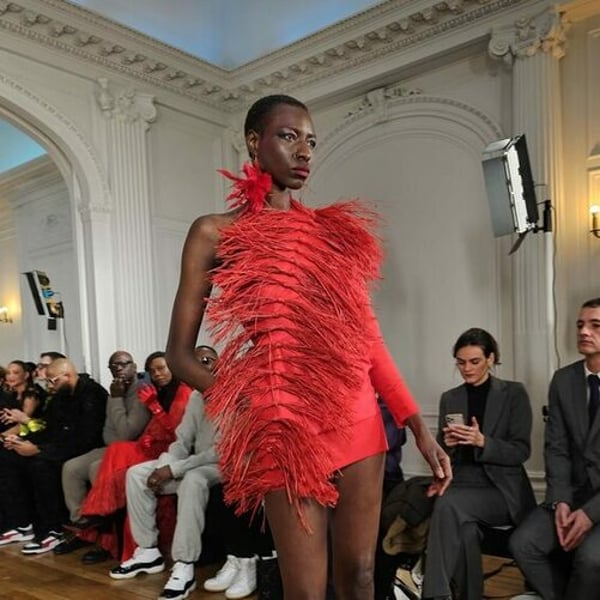
Imane Ayissi opens Paris Haute Couture Week celebrating African textile expertise
[ad_1]
Translated by
Nicola Mira
Published
Jan 23, 2024
Imane Ayissi opened Paris Haute Couture Week on Monday with his warm style brimming with vibrant colours and shimmering fabrics. Among the show’s guests, sitting front-row was French former footballer Lilian Thuram, a World Cup winner in 1998. As usual, Cameroon-born Ayissi shone a spotlight on Africa’s rich textiles and craftsmanship heritage, cleverly blending glamorous outfits and everyday items.

Ayissi concocted a high-energy colour mix, with a palette featuring red, fuchsia pink, orange, rust, and turquoise. He used shantung, lightweight silk, silk crepe, and glossy cotton to create sheath dresses, long draped dresses with trains, and more flowing dresses, expertly weaving together different strips of fabric. But he also presented an array of chic trousers, tops and slit blouses, easy to wear and match with everyday clothes.
The collection included patchwork overcoats made in Kenté, a fabric from Ghana woven by hand using an ancestral technique, and others made with thin strips of Faso Dan Fani, a traditional fabric from Burkina Faso. “I have been researching African fabrics extensively, but it’s difficult. We have an incredible textiles heritage that sadly Africans themselves are unaware of, having favoured wax-printed fabrics to the detriment of genuinely artisanal ones, whose manufacturing techniques have virtually disappeared,” Ayissi told FashionNetwork.com.
“I’m trying to recover and preserve this heritage, notably by using [such fabrics] in my collections. I’m staging masterclasses to train the younger generations in Africa,” he added. Ayissi also uses the self-regenerating bark of the obom tree, which he transforms into a material similar to leather. He uses it to make corsets and flowers he then attaches to some of his garments, like the wedding dress included in the Spring/Summer 2024 collection.
The tassels decorating many dresses and coats were instead made using raffia. “We buy [raffia] raw, then we cut it, process it and paint it, upgrading it,” said Ayissi, who has been based in Paris since 1993. He has been presenting his collections during haute couture week since 2010, and in 2020 he joined the week’s official calendar as an invited member, becoming the first designer from Sub-Saharan Africa to break into this highly restricted, exclusive circle.

Ayissi was born in Cameroon. His father was a boxer and his mother a model and he started his career as a ballet dancer, becoming a member of the Cameroon National Ballet. He then switched to modelling, and eventually returned to his childhood passion for dress-making, which he taught himself. He later launched his own label, catering to a clientèle from Paris, Africa and the USA.
“The golden age of haute couture is past. After the invasion of Iraq in 2003, everything changed. Not to mention the crises of the last few years. It’s all become very complicated. To keep my label in business, I’m forced to diversify, for example making limited-edition ready-to-wear in very small production runs, and accessories,” said Ayissi.
Among his latest creations, the ‘feather cloud’ earrings presented at the show and likely to become quite a success. They consist of a thin, nearly transparent chain whose length can be altered, with fabric petals in the shape of a flower attached at one end. The same flowery cloud is used as a brooch affixed to the shoulder or chest, elevating the looks.
Copyright © 2024 FashionNetwork.com All rights reserved.
[ad_2]
Source link




